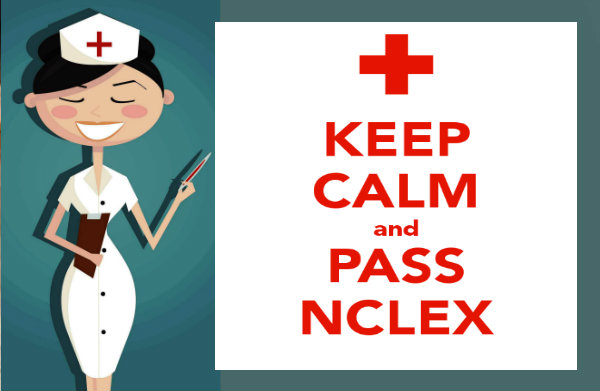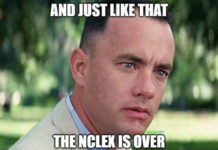#101. Answer: A
?Rationale:
Erythropoietin is released when the oxygen tension of the renal blood supply is low and stimulates production of red blood cells in the bone marrow. Hypotension causes activation of the renin-angiotensin-aldosterone system, as well as release of ADH. Hyperkalemia stimulates release of aldosterone from the adrenal cortex, and fluid overload does not directly stimulate factors affecting the kidney.
>>Return to NCLEX-RN Practice Questions (Part 4)<<
#102. Answer: D
Rationale:
The decreased ability to concentrate urine results in an increased volume of dilute urine, which does not maintain the usual diurnal elimination pattern. A decrease in bladder capacity also contributes to nocturia, but decreased bladder muscle tone results in urinary retention. Decreased renal mass decreases renal reserve, but function is generally adequate under normal circumstances.
>>Return to NCLEX-RN Practice Questions (Part 4)<<
#103. Answer: C
Rationale:
To assess for kidney tenderness, the nurse strikes the fist of one hand over the dorsum of the other hand at the posterior costovertebral angle. The upper abdominal quadrants and costovertebral angles are auscultated for vascular bruits in the renal vessels and aorta, and an empty bladder is not palpable. The kidneys are palpated through the abdomen, with the patient supine.
>>Return to NCLEX-RN Practice Questions (Part 4)<<
#104. Answer: B
Rationale:
Bacteria in warm urine specimens multiply rapidly, and false or unreliable bacterial counts may occur with old urine. Glucose, specific gravity, and WBCs do not change in urine specimens, but pH becomes more alkaline, RBCs are hemolyzed, and casts may disintegrate.
>>Return to NCLEX-RN Practice Questions (Part 4)<<
#105. Answer: A
Rationale:?
A urine specific gravity of 1.002 is low, indicating dluite urine and the excretion of excess fluid. Fluid overload, diuretics, or lack of ADH can cause dilute urine. Normal urine specific gravity indicates concentrated urine that would be seen in dehydration.
>>Return to NCLEX-RN Practice Questions (Part 4)<<
#106. Answer: C
Rationale:
Obesity is a risk factor for CVA. Other risk factors include a history of ischemic episodes, cardiovascular disease, diabetes mellitus, atherosclerosis of the cranial vessels, hypertension, polycythemia, smoking, hypercholesterolemia, oral contraceptive use, emotional stress, family history of CVA, and advancing age. The client’s race, sex, and bronchial asthma aren’t risk factors for CVA.
>>Return to NCLEX-RN Practice Questions (Part 4)<<
#107. Answer: B
Rationale:
Fatigue is a common symptom in clients with multiple sclerosis. Lowering the body temperature by resting in an air-conditioned room may relieve fatigue; however, extreme cold should be avoided. A hot bath or shower can increase body temperature, producing fatigue. Muscle relaxants, prescribed to reduce spasticity, can cause drowsiness and fatigue. Planning for frequent rest periods and naps can relieve fatigue. Other measures to reduce fatigue in the client with multiple sclerosis include treating depression, using occupational therapy to learn energy conservation techniques, and reducing spasticity.
>>Return to NCLEX-RN Practice Questions (Part 4)<<
#108. Answer: D
Rationale:
Protecting the client from injury is the immediate priority during a seizure. Elevating the head of the bed would have no effect on the client’s condition or safety. Restraining the client’s arms and legs could cause injury. Placing a tongue blade or other object in the client’s mouth could damage the teeth.
>>Return to NCLEX-RN Practice Questions (Part 4)<<
#109. Answer: A
Rationale: The nurse should inform the client that the paralysis that accompanies Guillain-Barré syndrome is only temporary. Return of motor function begins proximally and extends distally in the legs.
>>Return to NCLEX-RN Practice Questions (Part 4)<<
#110. Answer: A
Rationale:
The client who has had spinal surgery, such as laminectomy, must be logrolled to keep the spinal column straight when turning. The client who has had a thoracotomy or cystectomy may turn himself or may be assisted into a comfortable position. Under normal circumstances, hemorrhoidectomy is an outpatient procedure, and the client may resume normal activities immediately after surgery.
>>Return to NCLEX-RN Practice Questions (Part 4)<<
#111. Answer: B
Rationale:
Because CT commonly involves use of a contrast agent, the nurse should determine whether the client is allergic to iodine, contrast dyes, or shellfish. Neck immobilization is necessary only if the client has a suspected spinal cord injury. Placing a cap over the client’s head may lead to misinterpretation of test results; instead, the hair should be combed smoothly. The physician orders a sedative only if the client can’t be expected to remain still during the CT scan.
>>Return to NCLEX-RN Practice Questions (Part 4)<<
#112. Answer: B
Rationale:?
To prevent the attached muscle from contracting, the nurse should support the joint where the tendon is being tested. The nurse should use the flat, not pointed, end of the reflex hammer when striking the Achilles tendon. (The pointed end is used to strike over small areas, such as the thumb placed over the biceps tendon.) Tapping the tendon slowly and softly wouldn’t provoke a deep tendon reflex response. The nurse should hold the reflex hammer loosely, not tightly, between the thumb and fingers so it can swing in an arc.
>>Return to NCLEX-RN Practice Questions (Part 4)<<
#113. Answer: D
Rationale:
Because the client is disoriented and restless, the most important nursing diagnosis is risk for injury. Although the other options may be appropriate, they’re secondary because they don’t immediately affect the client’s health or safety.
>>Return to NCLEX-RN Practice Questions (Part 4)<<
#114. Answer: B
Rationale:
This comment best supports a nursing diagnosis of Powerlessness because ALS may lead to locked-in syndrome, characterized by an active and functioning mind locked in a body that can’t perform even simple daily tasks. Although Anxiety and Risk for disuse syndrome may be diagnoses associated with ALS, the client’s comment specifically refers to an inability to act autonomously. A diagnosis of Ineffective denial would be indicated if the client didn’t seem to perceive the personal relevance of symptoms or danger.
>>Return to NCLEX-RN Practice Questions (Part 4)<<
#115. Answer: C
Rationale:
The goal of treatment is to prevent acidemia by eliminating carbon dioxide. That is because an acid environment in the brain causes cerebral vessels to dilate and therefore increases ICP. Preventing respiratory alkalosis and lowering arterial pH may bring about acidosis, an undesirable condition in this case. It isn’t necessary to maintain a PaO2 as high as 80 mm Hg; 60 mm Hg will adequately oxygenate most clients.
>>Return to NCLEX-RN Practice Questions (Part 4)<<
#116. Answer: C
Rationale:?
If a neck injury is suspected, the jaw thrust maneuver is used to open the airway. The head tilt–chin lift maneuver produces hyperextension of the neck and could cause complications if a neck injury is present. A flexed position is an inappropriate position for opening the airway.
>>Return to NCLEX-RN Practice Questions (Part 4)<<
#117. Answer: B
Rationale:
Motor testing in the unconscious client can be done only by testing response to painful stimuli. Nail bed pressure tests a basic peripheral response. Cerebral responses to pain are tested using sternal rub, placing upward pressure on the orbital rim, or squeezing the clavicle or sternocleidomastoid muscle.
>>Return to NCLEX-RN Practice Questions (Part 4)<<
#118. Answer: C
Rationale:
The client having a magnetic resonance imaging scan has all metallic objects removed because of the magnetic field generated by the device. A careful history is obtained to determine whether any metal objects are inside the client, such as orthopedic hardware, pacemakers, artificial heart valves, aneurysm clips, or intrauterine devices. These may heat up, become dislodged, or malfunction during this procedure. The client may be ineligible if significant risk exists.
>>Return to NCLEX-RN Practice Questions (Part 4)<<
#119. Answer: D
?Rationale:
The client undergoing lumbar puncture is positioned lying on the side, with the legs pulled up to the abdomen and the head bent down onto the chest. This position helps open the spaces between the vertebrae.
>>Return to NCLEX-RN Practice Questions (Part 4)<<
#120. Answer: B
Rationale:
The head of the client with increased intracranial pressure should be positioned so the head is in a neutral midline position. The nurse should avoid flexing or extending the client’s neck or turning the head side to side. The head of the bed should be raised to 30 to 45 degrees. Use of proper positions promotes venous drainage from the cranium to keep intracranial pressure down.
>>Return to NCLEX-RN Practice Questions (Part 4)<<
#121. Answer: D
Rationale:
Leakage of cerebrospinal fluid (CSF) from the ears or nose may accompany basilar skull fracture. CSF can be distinguished from other body fluids because the drainage will separate into bloody and yellow concentric rings on dressing material, called a halo sign. The fluid also tests positive for glucose.
>>Return to NCLEX-RN Practice Questions (Part 4)<<
#122. Answer: D
Rationale:
The most frequent cause of autonomic dysreflexia is a distended bladder. Straight catheterization should be done every 4 to 6 hours, and foley catheters should be checked frequently to prevent kinks in the tubing. Constipation and fecal impaction are other causes, so maintaining bowel regularity is important. Other causes include stimulation of the skin from tactile, thermal, or painful stimuli. The nurse administers care to minimize risk in these areas.
>>Return to NCLEX-RN Practice Questions (Part 4)<<
#123. Answer: B
Rationale:
Nursing actions during a seizure include providing for privacy, loosening restrictive clothing, removing the pillow and raising side rails in the bed, and placing the client on one side with the head flexed forward, if possible, to allow the tongue to fall forward and facilitate drainage. The limbs are never restrained because the strong muscle contractions could cause the client harm. If the client is not in bed when seizure activity begins, the nurse lowers the client to the floor, if possible, protects the head from injury, and moves furniture that may injure the client. Other aspects of care are as described for the client who is in bed.
>>Return to NCLEX-RN Practice Questions (Part 4)<<
#124. Answer: B
Rationale:
Hemiparesis is a weakness of one side of the body that may occur after a stroke. Complete hemiparesis is weakness of the face and tongue, arm, and leg on one side. Complete bilateral paralysis does not occur in this condition. The client with right-sided hemiparesis has weakness of the right arm and leg and needs assistance with feeding, bathing, and ambulating.
>>Return to NCLEX-RN Practice Questions (Part 4)<<
#125. Answer: A
Rationale:
Before the client with dysphagia is started on a diet, the gag and swallow reflexes must have returned. The client is assisted with meals as needed and is given ample time to chew and swallow. Food is placed on the unaffected side of the mouth. Liquids are thickened to avoid aspiration.
>>Return to NCLEX-RN Practice Questions (Part 4)<<
#126. Answer: D
Rationale:
Clients are evaluated as coping successfully with lifestyle changes after a brain attack (stroke) if they make appropriate lifestyle alterations, use the assistance of others, and have appropriate social interactions. Options A, B, and C are not adaptive behaviors.
>>Return to NCLEX-RN Practice Questions (Part 4)<<
#127. Answer: C
Rationale:
Clients with aphasia after brain attack (stroke) often fatigue easily and have a short attention span. General guidelines when trying to communicate with the aphasic client include speaking more slowly and allowing adequate response time, listening to and watching attempts to communicate, and trying to put the client at ease with a caring and understanding manner. The nurse would avoid shouting (because the client is not deaf), appearing rushed for a response, and letting family members provide all the responses for the client.
>>Return to NCLEX-RN Practice Questions (Part 4)<<
#128. ?Answer: C
Rationale:
Myasthenic crisis often is caused by undermedication and responds to the administration of cholinergic medications, such as neostigmine (Prostigmin) and pyridostigmine (Mestinon). Cholinergic crisis (the opposite problem) is caused by excess medication and responds to withholding of medications. Too little exercise and fatty food intake are incorrect. Overexertion and overeating possibly could trigger myasthenic crisis.
>>Return to NCLEX-RN Practice Questions (Part 4)<<
#129. Answer: D
Rationale:
Clients with myasthenia gravis are taught to space out activities over the day to conserve energy and restore muscle strength. Taking medications correctly to maintain blood levels that are not too low or too high is important. Muscle-strengthening exercises are not helpful and can fatigue the client. Overeating is a cause of exacerbation of symptoms, as is exposure to heat, crowds, erratic sleep habits, and emotional stress.
>>Return to NCLEX-RN Practice Questions (Part 4)<<
#130. Answer: A
Rationale:
Bell’s palsy is a one-sided facial paralysis from compression of the facial nerve. The exact cause is unknown, but may include vascular ischemia, infection, exposure to viruses such as herpes zoster or herpes simplex, autoimmune disease, or a combination of these factors.
>>Return to NCLEX-RN Practice Questions (Part 4)<<
#131. Answer: A
Rationale:
Prevention of muscle atrophy with Bell’s palsy is accomplished with facial massage, facial exercises, and electrical stimulation of the nerves. Exposure to cold or drafts is avoided. Local application of heat to the face may improve blood flow and provide comfort.
>>Return to NCLEX-RN Practice Questions (Part 4)<<
#132. Answer: D
Rationale:
Guillain-Barré syndrome is a clinical syndrome of unknown origin that involves cranial and peripheral nerves. Many clients report a history of respiratory or gastrointestinal infection in the 1 to 4 weeks before the onset of neurological deficits. Occasionally, the syndrome can be triggered by vaccination or surgery.
>>Return to NCLEX-RN Practice Questions (Part 4)<<
#133. Answer: C
Rationale:
The client with Guillain-Barré syndrome experiences fear and anxiety from the ascending paralysis and sudden onset of the disorder. The nurse can alleviate these fears by providing accurate information about the client’s condition, giving expert care and positive feedback to the client, and encouraging relaxation and distraction. The family can become involved with selected care activities and provide diversion for the client as well.
>>Return to NCLEX-RN Practice Questions (Part 4)<<
#134. Answer: D
Rationale:
Cranial nerve II is the optic nerve, which governs vision. The nurse can provide safety for the visually impaired client by clearing the path of obstacles when ambulating. Testing the shower water temperature would be useful if there were an impairment of peripheral nerves. Speaking loudly may help overcome a deficit of cranial nerve VIII (vestibulocochlear). Cranial nerve VII (facial) and IX (glossopharyngeal) control taste from the anterior two thirds and posterior third of the tongue, respectively.
>>Return to NCLEX-RN Practice Questions (Part 4)<<
#135. Answer: B
Rationale:
The limbic system is responsible for feelings (affect) and emotions. Calculation ability and knowledge of current events relates to function of the frontal lobe. The cerebral hemispheres, with specific regional functions, control orientation. Recall of recent events is controlled by the hippocampus.
>>Return to NCLEX-RN Practice Questions (Part 4)<<
#136. Answer: A
Rationale:
The body’s thermostat is located in the hypothalamus; therefore, injury to that area can cause problems of body temperature control. Balance and equilibrium problems are related to cerebellar damage. Visual acuity problems would occur following occipital or optic nerve injury. Thinking and reasoning problems are the result of injury to the cerebrum.
>>Return to NCLEX-RN Practice Questions (Part 4)<<
#137. Answer: C
Rationale:
Administering lidocaine via an endotracheal tube may minimize elevations in ICP caused by suctioning. Although mannitol and furosemide may be given to reduce ICP, they’re administered parenterally, not endotracheally. Phenytoin doesn’t reduce ICP directly but may be used to abolish seizures, which can increase ICP. However, phenytoin isn’t administered endotracheally.
>>Return to NCLEX-RN Practice Questions (Part 4)<<
#138. Answer: C
Rationale:
The client’s history and assessment suggest that he may have increased intracranial pressure (ICP). If this is the case, lumbar puncture shouldn’t be done because it can quickly decompress the central nervous system and, thereby, cause additional damage. After a head injury, barbiturates may be given to prevent seizures; mechanical ventilation may be required if breathing deteriorates; and elevating the head of the bed may be used to reduce ICP.
>>Return to NCLEX-RN Practice Questions (Part 4)<<
#139. Answer: A
Rationale:
The sudden appearance of light flashes and floaters in front of the affected eye is characteristic of retinal detachment. Difficulty seeing cars in another driving lane suggests gradual loss of peripheral vision, which may indicate glaucoma. Headache, nausea, and redness of the eyes are signs of acute (angle-closure) glaucoma. Double vision is common in clients with cataracts.
>>Return to NCLEX-RN Practice Questions (Part 4)<<
#140. Answer: B
Rationale:
In Parkinson’s crisis, dopamine-related symptoms are severely exacerbated, virtually immobilizing the client. A client confined to bed during such a crisis is at risk for aspiration and pneumonia. Also, excessive drooling increases the risk of airway obstruction. Because of these concerns, the nursing diagnosis of Ineffective airway clearance takes highest priority. Although the other options also are appropriate, they aren’t immediately life-threatening.
>>Return to NCLEX-RN Practice Questions (Part 4)<<
#141. Answer: A
Rationale:
Staying with the client and encouraging him to feed himself will ensure adequate food intake. A client with Alzheimer’s disease can forget how to eat. Allowing privacy during meals, filling out the menu, or helping the client to complete the menu doesn’t ensure adequate nutritional intake.
>>Return to NCLEX-RN Practice Questions (Part 4)<<
#142. Answer: C
Rationale:
The mental status examination assesses functions governed by the cerebrum. Some of these are orientation, attention span, judgment, and abstract reasoning. Intellectual functioning isn’t the only cerebral activity. Cerebellar function testing assesses coordination, equilibrium, and fine motor movement. Sensory function testing involves assessment of pain, light-touch sensation, and temperature discrimination.
>>Return to NCLEX-RN Practice Questions (Part 4)<<
#143. Answer: B
Rationale:
When used to treat status epilepticus, diazepam may be given every 10 to 15 minutes, as needed, to a maximum dose of 30 mg. The nurse can repeat the regimen in 2 to 4 hours, if necessary, but the total dose shouldn’t exceed 100 mg in 24 hours. The nurse must not administer I.V. diazepam faster than 5 mg/minute. Therefore, the dose can’t be repeated in 30 to 45 seconds because the first dose wouldn’t have been administered completely by that time. Waiting longer than 15 minutes to repeat the dose would increase the client’s risk of complications associated with status epilepticus.
>>Return to NCLEX-RN Practice Questions (Part 4)<<
#144. Answer: D
Rationale:
Atropine sulfate is a cholinergic blocker. It isn’t a parasympathomimetic agent, a sympatholytic agent, or an adrenergic blocker.
>>Return to NCLEX-RN Practice Questions (Part 4)<<
#145. Answer: A
Rationale:
In the scenario, airway and breathing are established so the nurse’s next priority should be circulation. With a compound fracture of the femur, there is a high risk of profuse bleeding; therefore, the nurse should assess the site. Neurologic assessment is a secondary concern to airway, breathing, and circulation. The nurse doesn’t have enough data to warrant putting the client in Trendelenburg’s position.
>>Return to NCLEX-RN Practice Questions (Part 4)<<
#146. Answer: B
Rationale:
Dexamethasone exerts its therapeutic effect by decreasing leukocyte infiltration at the site of ocular inflammation. This reduces the exudative reaction of diseased tissue, lessening edema, redness, and scarring. Dexamethasone and other anti-inflammatory agents don’t inhibit the action of carbonic anhydrase or produce any type of miotic reaction.
>>Return to NCLEX-RN Practice Questions (Part 4)<<
#147. Answer: C
Rationale:
Urine retention or incontinence may indicate cauda equina syndrome, which requires immediate surgery. An increase in pain on the second postoperative day is common because the long-acting local anesthetic, which may have been injected during surgery, will wear off. While paresthesia is common after surgery, progressive weakness or paralysis may indicate spinal nerve compression. A mild fever is also common after surgery but is considered significant only if it reaches 101° F (38.3° C).
>>Return to NCLEX-RN Practice Questions (Part 4)<<
#148. Answer: B
Rationale:
The abbreviation “gtt” stands for drop, “i” is the apothecary symbol for the number 1, OU signifies both eyes, and “q.i.d.” means four times a day. Therefore, one drop of pilocarpine 0.25% should be instilled into both eyes four times daily.
>>Return to NCLEX-RN Practice Questions (Part 4)<<
#149. Answer: B
Rationale:
Using a mirror enables the client to inspect all areas of the skin for signs of breakdown without the help of staff or family members. The client should keep the side rails up to help with repositioning and to prevent falls. The paralyzed client should take responsibility for repositioning or for reminding the staff to assist with it, if needed. A client with left-side paralysis may not realize that the left arm is hanging over the side of the wheelchair. However, the nurse should call this to the client’s attention because the arm can get caught in the wheel spokes or develop impaired circulation from being in a dependent position for too long.
>>Return to NCLEX-RN Practice Questions (Part 4)<<
#150. Answer: C
Rationale:
A helicopod gait is an abnormal gait in which the client’s feet make a half circle with each step. An ataxic gait is staggering and unsteady. In a dystrophic gait, the client waddles with the legs far apart. In a steppage gait, the feet and toes raise high off the floor and the heel comes down heavily with each step.
>>Return to NCLEX-RN Practice Questions (Part 4)<<
#151. Answer: B
Rationale:
A client with bacterial meningitis should be kept in isolation for at least 24 hours after admission and, during the initial acute phase, should be as close to the nurses’ station as possible to allow maximal observation. Placing the client in a room with a client who has viral meningitis may cause harm to both clients because the organisms causing viral and bacterial meningitis differ; either client may contract the other’s disease. Immunity to bacterial meningitis can’t be acquired; therefore, a client who previously had bacterial meningitis shouldn’t be put at risk by rooming with a client who has just been diagnosed with this disease.
>>Return to NCLEX-RN Practice Questions (Part 4)<<
#152. Answer: C
Rationale:?
Anticholinesterase agents such as pyridostigmine are contraindicated in a client with a mechanical obstruction of the intestines or urinary tract, peritonitis, or hypersensitivity to anticholinesterase agents. Ulcerative colitis, blood dyscrasia, and spinal cord injury don’t contraindicate use of the drug.
>>Return to NCLEX-RN Practice Questions (Part 4)<<
#153. Answer: A
Rationale:
Ménière’s disease, an inner ear disease, is characterized by the symptom triad of vertigo, tinnitus, and hearing loss. The combination of vertigo, vomiting, and nystagmus suggests labyrinthitis. Ménière’s disease rarely causes pain, blurred vision, or fever.
>>Return to NCLEX-RN Practice Questions (Part 4)<<
#154. Answer: D
Rationale:
For 30 days after a stapedectomy, the client should avoid air travel, sudden movements that may cause trauma, and exposure to loud sounds and pressure changes (such as from high altitudes). Immediately after surgery, the client should lie flat with the surgical ear facing upward; nose blowing is permitted but should be done gently and on one side at a time. The client’s first attempt at postoperative ambulation should be supervised to prevent falls caused by vertigo and light-headedness. The client must avoid shampooing and swimming to keep the dressing and the ear dry.
>>Return to NCLEX-RN Practice Questions (Part 4)<<
#155. Answer: C
Rationale:
The most common adverse reaction to dantrolene is muscle weakness. The drug also may depress liver function or cause idiosyncratic hepatitis. Muscle weakness is rarely severe enough to cause slurring of speech, drooling, and enuresis. Although excessive tearing and urine retention are adverse reactions associated with dantrolene use, they aren’t as common as muscle weakness.
>>Return to NCLEX-RN Practice Questions (Part 4)<<
#156. Answer: A
Rationale:
Systemic absorption of atropine sulfate can cause tachycardia, palpitations, flushing, dry skin, ataxia, and confusion. To minimize systemic absorption, the client should apply digital pressure over the punctum at the inner canthus for 2 to 3 minutes after instilling the drops. The drug also may cause dry mouth. It isn’t known to cause hypotension or apnea.
>>Return to NCLEX-RN Practice Questions (Part 4)<<
#157. Answer: B
Rationale:
Because a cervical spine injury can cause respiratory distress, the nurse should take immediate action to maintain a patent airway and provide adequate oxygenation. The other options may be appropriate for a client with a spinal cord injury — particularly during the course of recovery — but don’t take precedence over a diagnosis of Ineffective breathing pattern.
>>Return to NCLEX-RN Practice Questions (Part 4)<<
#158. Answer: D
Rationale:
In addition to relieving painful muscle spasms, diazepam also is recommended for treatment of spasticity associated with spinal cord lesions. Diazepam’s use is limited by its central nervous system effects and the tolerance that develops with prolonged use. The parenteral form of diazepam can treat status epilepticus, but the drug’s sedating properties make it an unsuitable choice for long-term management of epilepsy. Diazepam isn’t an analgesic agent.
>>Return to NCLEX-RN Practice Questions (Part 4)<<
#159. Answer: C
Rationale:
To elicit the oculocephalic response, which detects cranial nerve compression, the nurse turns the client’s head suddenly while holding the eyelids open. Normally, the eyes move from side to side when the head is turned; in an abnormal response, the eyes remain fixed. The nurse introduces ice water into the external auditory canal when testing the oculovestibular response; normally, the client’s eyes deviate to the side of ice water introduction. The nurse touches the client’s cornea with a wisp of cotton to elicit the corneal reflex response, which reveals brain stem function; blinking is the normal response. Shining a bright light into the client’s pupil helps evaluate brain stem and cranial nerve III functions; normally, the pupil responds by constricting.
>>Return to NCLEX-RN Practice Questions (Part 4)<<
#160. ?Answer: D
Rationale:
The nurse must cautiously administer pancuronium, succinylcholine, and any other neuromuscular blocking agent to a client with myasthenia gravis. Such a client isn’t less sensitive to the effects of a neuromuscular blocking agent. Either succinylcholine or pancuronium can be administered in the usual adult dosage to a client with myasthenia gravis.
>>Return to NCLEX-RN Practice Questions (Part 4)<<
#161. Answer: B
Rationale:
Cones provide daylight color vision, and their stimulation is interpreted as color. If one or more types of cones are absent or defective, color blindness occurs. Rods are sensitive to low levels of illumination but can’t discriminate color. The lens is responsible for focusing images. Aqueous humor is a clear watery fluid and isn’t involved with color perception.
>>Return to NCLEX-RN Practice Questions (Part 4)<<
#162. Answer: C
Rationale:
Decerebrate posturing, characterized by abnormal extension in response to painful stimuli, indicates damage to the midbrain. With damage to the diencephalon or cortex, abnormal flexion (decorticate posturing) occurs when a painful stimulus is applied. Damage to the medulla results in flaccidity.
>>Return to NCLEX-RN Practice Questions (Part 4)<<
#163. Answer: A
Rationale:
Vision changes, such as diplopia, nystagmus, and blurred vision, are symptoms of multiple sclerosis. Deep tendon reflexes may be increased or hyperactive — not absent. Babinski’s sign may be positive. Tremors at rest aren’t characteristic of multiple sclerosis; however, intentional tremors, or those occurring with purposeful voluntary movement, are common in clients with multiple sclerosis. Affected muscles are spastic, rather than flaccid.
>>Return to NCLEX-RN Practice Questions (Part 4)<<
#164. Answer: D
Rationale:
The headache may be an indication that the aneurysm is leaking. The nurse should notify the physician immediately. Sitting with the client is appropriate but only after the physician has been notified of the change in the client’s condition. The physician will decide whether or not administration of an analgesic is indicated. Informing the nurse manager isn’t necessary.
>>Return to NCLEX-RN Practice Questions (Part 4)<<
#165. Answer: D
Rationale:
Swallowing is a motor function of cranial nerves IX and X. Cranial nerves I, II, and VIII don’t possess motor functions. The motor functions of cranial nerve III include extraocular eye movement, eyelid elevation, and pupil constriction. The motor function of cranial nerve V is chewing. Cranial nerve VI controls lateral eye movement.
>>Return to NCLEX-RN Practice Questions (Part 4)<<
#166. Answer: C
Rationale:
Sildenafil (Viagra) enhances the vasodilating effect of nitric oxide in the corpus cavernosum of the penis, thus sustaining an erection. Because of the effect of the medication, it is contraindicated with concurrent use of organic nitrates and nitroglycerin. Sildenafil is not contraindicated with the use of vitamins. Neuralgia and insomnia are side effects of the medication.
>>Return to NCLEX-RN Practice Questions (Part 4)<<
#167. Answer: D
Rationale:
Ecotrin is an aspirin-containing product and should be avoided. Alcohol consumption should be avoided by a client taking warfarin sodium. Taking prescribed medication at the same time each day increases client compliance. The Medic-Alert bracelet provides health care personnel emergency information.
>>Return to NCLEX-RN Practice Questions (Part 4)<<
#168. Answer: D
Rationale:
The PT will assess for the therapeutic effect of warfarin sodium (Coumadin) and the aPTT will assess the therapeutic effect of heparin sodium. Heparin sodium doses are determined based on these laboratory results. The hemoglobin and hematocrit values assess red blood cell concentrations.
>>Return to NCLEX-RN Practice Questions (Part 4)<<
#169. Answer: B
Rationale:
Audible expiratory wheezes may indicate a serious adverse reaction, bronchospasm. β-Blockers may induce this reaction, particularly in clients with chronic obstructive pulmonary disease or asthma. Normal decreases in blood pressure and heart rate are expected. Insomnia is a frequent mild side effect and should be monitored.
>>Return to NCLEX-RN Practice Questions (Part 4)<<
#170. Answer: D
Rationale:
Toxicity (overdosage) of this medication produces central nervous system excitation, such as nervousness, restlessness, hallucinations, and irritability. Other signs of toxicity include hypotension or hypertension, confusion, tachycardia, flushed or red face, and signs of respiratory depression. Drowsiness is a frequent side effect of the medication but does not indicate overdosage.
>>Return to NCLEX-RN Practice Questions (Part 4)<<
#171. Answer: D
Rationale:
Cholinergic crisis occurs as a result of an overdose of medication. Indications of cholinergic crisis include gastrointestinal disturbances, nausea, vomiting, diarrhea, abdominal cramps, increased salivation and tearing, miosis, hypertension, sweating, and increased bronchial secretions.
>>Return to NCLEX-RN Practice Questions (Part 4)<<
#172. Answer: B
Rationale:
The antidote for cholinergic crisis is atropine sulfate. Vitamin K is the antidote for warfarin (Coumadin). Protamine sulfate is the antidote for heparin, and acetylcysteine (Mucomyst) is the antidote for acetaminophen (Tylenol).
>>Return to NCLEX-RN Practice Questions (Part 4)<<
#173. Answer: D
Rationale:
Dyskinesia and impaired voluntary movement may occur with high levodopa dosages. Nausea, anorexia, dizziness, orthostatic hypotension, bradycardia, and akinesia (the temporary muscle weakness that lasts 1 minute to 1 hour, also known as the “on-off phenomenon”) are frequent side effects of the medication.
>>Return to NCLEX-RN Practice Questions (Part 4)<<
#174. Answer: A
Rationale:
Phenytoin (Dilantin) is an anticonvulsant. Gingival hyperplasia, bleeding, swelling, and tenderness of the gums can occur with the use of this medication. The client needs to be taught good oral hygiene, gum massage, and the need for regular dentist visits. The client should not skip medication doses, because this could precipitate a seizure. Capsules should not be chewed or broken and they must be swallowed. The client needs to be instructed to report a sore throat, fever, glandular swelling, or any skin reaction, because this indicates hematological toxicity.
>>Return to NCLEX-RN Practice Questions (Part 4)<<
#175. Answer: B
Rationale:
The therapeutic serum drug level range for phenytoin (Dilantin) is 10 to 20 mcg/mL.
* A helpful hint may be to remember that the theophylline therapeutic range and the acetaminophen (Tylenol) therapeutic range are the same as the phenytoin (Dilantin) therapeutic range.*
>>Return to NCLEX-RN Practice Questions (Part 4)<<
#176. Answer: A
Rationale:
Ibuprofen is a nonsteroidal anti-inflammatory drug (NSAID). NSAIDs should be given with milk or food to prevent gastrointestinal irritation. Options 2, 3, and 4 are incorrect.
>>Return to NCLEX-RN Practice Questions (Part 4)<<
#177. Answer: C
Rationale:
Phenytoin (Dilantin) enhances the rate of estrogen metabolism, which can decrease the effectiveness of some birth control pills. Options 1, 2, are 4 are not accurate.
>>Return to NCLEX-RN Practice Questions (Part 4)<<
#178. Answer: C
Rationale:
Adverse effects of carbamazepine (Tegretol) appear as blood dyscrasias, including aplastic anemia, agranulocytosis, thrombocytopenia, leukopenia, cardiovascular disturbances, thrombophlebitis, dysrhythmias, and dermatological effects. Options 1, 2, and 4 identify normal laboratory values.
>>Return to NCLEX-RN Practice Questions (Part 4)<<
#179. Answer: B
Rationale:
Dantrium acts directly on skeletal muscle to relieve muscle spasticity. The primary action is the suppression of calcium release from the sarcoplasmic reticulum. This in turn decreases the ability of the skeletal muscle to contract.
*Options 1, 3, and 4 are all comparable or alike in that they address CNS suppression and the depression of reflexes. Therefore, eliminate these options.*
>>Return to NCLEX-RN Practice Questions (Part 4)<<
#180. Answer: B
Rationale:
Dose-related liver damage is the most serious adverse effect of dantrolene. To reduce the risk of liver damage, liver function tests should be performed before treatment and periodically throughout the treatment course. It is administered in the lowest effective dosage for the shortest time necessary.
*Eliminate options 1 and 3 because these tests both assess kidney function.*
>>Return to NCLEX-RN Practice Questions (Part 4)<<
#181. Answer: A
Rationale:
Because this medication has anticholinergic effects, it should be used with caution in clients with a history of urinary retention, angle-closure glaucoma, and increased intraocular pressure. Cyclobenzaprine hydrochloride should be used only for short-term 2- to 3-week therapy.
>>Return to NCLEX-RN Practice Questions (Part 4)<<
#182. Answer: D
Rationale:
Disulfiram is used as an adjunct treatment for selected clients with chronic alcoholism who want to remain in a state of enforced sobriety. Clients must abstain from alcohol intake for at least 12 hours before the initial dose of the medication is administered. The most important data are to determine when the last alcoholic drink was consumed. The medication is used with caution in clients with diabetes mellitus, hypothyroidism, epilepsy, cerebral damage, nephritis, and hepatic disease. It is also contraindicated in severe heart disease, psychosis, or hypersensitivity related to the medication.
>>Return to NCLEX-RN Practice Questions (Part 4)<<
#183. Answer: A
Rationale:
Donepezil hydrochloride is a cholinergic agent used in the treatment of mild to moderate dementia of the Alzheimer type. It enhances cholinergic functions by increasing the concentration of acetylcholine. It slows the progression of Alzheimer’s disease. Options 2, 3, and 4 are incorrect.
>>Return to NCLEX-RN Practice Questions (Part 4)<<
#184. Answer: C
Rationale:
Fluoxetine hydrochloride is administered in the early morning without consideration to meals.
*Eliminate options 1, 2, and 4 because they are comparable or alike and indicate taking the medication with an antacid or food.*
>>Return to NCLEX-RN Practice Questions (Part 4)<<
#185. Answer: C
Rationale:
Depressed individuals will sleep for long periods, are not able to go to work, and feel as if they cannot “do anything.” Once they have had some therapeutic effect from their medication, they will report resolution of many of these complaints as well as demonstrate an improvement in their appearance.
>>Return to NCLEX-RN Practice Questions (Part 4)<<
#186. Answer: B
Rationale:
The most common adverse effects related to fluoxetine include central nervous system (CNS) and gastrointestinal (GI) system dysfunction. This medication affects the GI system by causing nausea and vomiting, cramping, and diarrhea. Options 1, 3, and 4 are not adverse effects of this medication.
>>Return to NCLEX-RN Practice Questions (Part 4)<<
#187. Answer: A
Rationale:?
Buspirone hydrochloride is not recommended for the treatment of drug or alcohol withdrawal, paranoid thought disorders, or schizophrenia (thought broadcasting or delusions). Buspirone hydrochloride is most often indicated for the treatment of anxiety and aggression.
>>Return to NCLEX-RN Practice Questions (Part 4)<<
#188. Answer: C
Rationale:
Bupropion does not cause significant orthostatic blood pressure changes. Seizure activity is common in dosages greater than 450 mg daily. Bupropion frequently causes a drop in body weight. Insomnia is a side effect, but seizure activity causes a greater client risk.
>>Return to NCLEX-RN Practice Questions (Part 4)<<
#189. Answers: A, B, D
Rationale:
Phenelzine sulfate (Nardil) is a monoamine oxidase inhibitor(MAOI). The client should avoid taking in foods that are high in tyramine. Use of these foods could trigger a potentially fatal hypertensive crisis. Some foods to avoid include yogurt, aged cheeses, smoked or processed meats, red wines, and fruits such as avocados, raisins, and figs.
>>Return to NCLEX-RN Practice Questions (Part 4)<<
#190. Answer: D
Rationale:
β-Adrenergic blocking agents, such as atenolol, inhibit the appearance of signs and symptoms of acute hypoglycemia, which would include nervousness, increased heart rate, and sweating. Therefore, the client receiving this medication should adhere to the therapeutic regimen and monitor blood glucose levels carefully. Option 4 is the most reliable indicator of hypoglycemia.
>>Return to NCLEX-RN Practice Questions (Part 4)<<
#191. Answer: A
Rationale:
Digoxin is a cardiac glycoside that is used to treat heart failure and acts by increasing the force of myocardial contraction. Because bradycardia may be a clinical sign of toxicity, the nurse counts the apical heart rate for 1 full minute before administering the medication. If the pulse rate is less than 60 beats/minute in an adult client, the nurse would withhold the medication and report the pulse rate to the registered nurse, who would then contact the health care provider.
>>Return to NCLEX-RN Practice Questions (Part 4)<<
#192. Answers: B, C, D
Rationale:
Furosemide is a loop diuretic; therefore, an expected effect is increased urinary frequency. Nausea is a frequent side effect, not an adverse effect. Photosensitivity is an occasional side effect. Adverse effects include tinnitus (ototoxicity), hypotension, and hypokalemia and occur as a result of sudden volume depletion.
>>Return to NCLEX-RN Practice Questions (Part 4)<<
#193. Answer: C
Rationale:
Alcohol will lower the seizure threshold and should be avoided. Adolescents can obtain a driver’s license in most states when they have been seizure free for 1 year. Anticonvulsants cause acne and oily skin; therefore a dermatologist may need to be consulted. If an anticonvulsant medication is missed, the health care provider should be notified.
>>Return to NCLEX-RN Practice Questions (Part 4)<<
#194. Answer: C
Rationale:
Double vision, loss of appetite, and nausea are signs of digoxin toxicity. Additional signs of digoxin toxicity include bradycardia, difficulty reading, visual alterations such as green and yellow vision or seeing spots or halos, confusion, vomiting, diarrhea, decreased libido, and impotence.
*gastrointestinal (GI) and visual disturbances occur with digoxin toxicity*
>>Return to NCLEX-RN Practice Questions (Part 4)<<
#195. Answer: C
Rationale:
Bumetanide is a loop diuretic. Hypotension is a common side effect associated with the use of this medication. The other options also require assessment but are not the priority.
*priority ABCs—airway, breathing, and circulation*
>>Return to NCLEX-RN Practice Questions (Part 4)<<
#196. Answer: A
Rationale:
The antidote to heparin is protamine sulfate; it should be readily available for use if excessive bleeding or hemorrhage occurs. Potassium chloride is administered for a potassium deficit. Vitamin K is an antidote for warfarin sodium. Aminocaproic acid is the antidote for thrombolytic therapy.
>>Return to NCLEX-RN Practice Questions (Part 4)<<
#197. Answer: D
Rationale:
Meperidine hydrochloride (Demerol) is an opioid analgesic. Side effects of this medication include respiratory depression, orthostatic hypotension, tachycardia, drowsiness and mental clouding, constipation, and urinary retention.
>>Return to NCLEX-RN Practice Questions (Part 4)<<
#198. Answer: B
Rationale:
Carbamazepine (Tegretol) is contraindicated in liver disease, and liver function tests are routinely prescribed for baseline purposes and are monitored during therapy. It is also contraindicated if the client has a history of blood dyscrasias. It is not contraindicated in the conditions noted in the incorrect options.
>>Return to NCLEX-RN Practice Questions (Part 4)<<
#199. Answer: C
Rationale:
The client needs to be told that the urine may turn brown, black, or green. Other adverse effects include blurred vision, nasal congestion, urticaria, and rash. The client needs to be instructed that, if these adverse effects occur, the health care provider needs to be notified. The medication is used to relieve muscle spasms.
>>Return to NCLEX-RN Practice Questions (Part 4)<<
#200. Answer: B
Rationale:
Atenolol hydrochloride is a beta-blocker used to treat hypertension. Therefore the priority nursing action before administration of the medication is to check the client’s blood pressure. The nurse also checks the client’s apical heart rate. If the systolic blood pressure is below 90 mm Hg or the apical pulse is 60 beats per minute or lower, the medication is withheld and the registered nurse and/or health care provider is notified. The nurse would check baseline renal and liver function tests. The medication may cause weakness, and the nurse would assist the client with activities if weakness occurs.
*Beta-blockers have “-lol” at the end of the medication name*
>>Return to NCLEX-RN Practice Questions (Part 4)<<



















